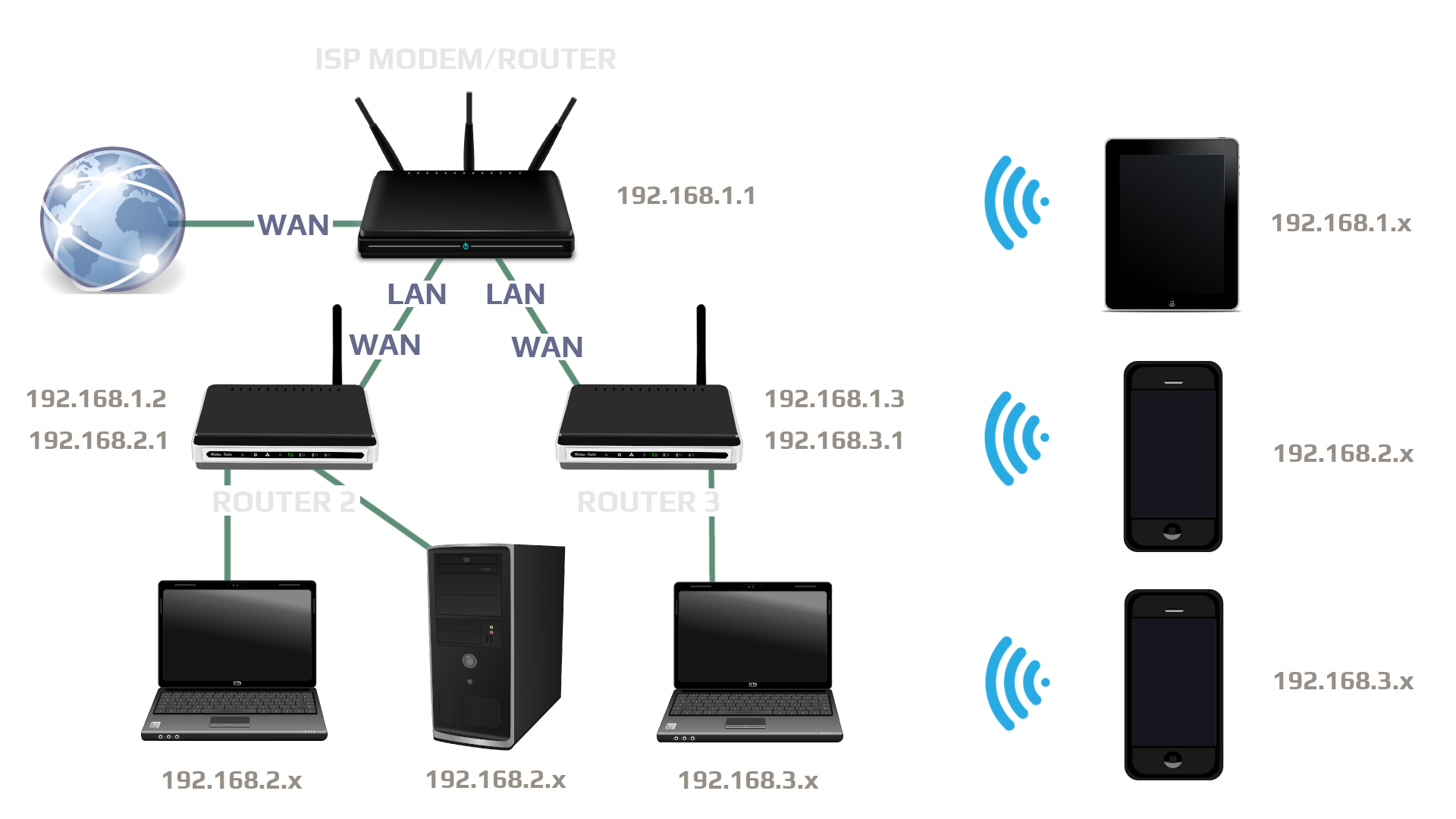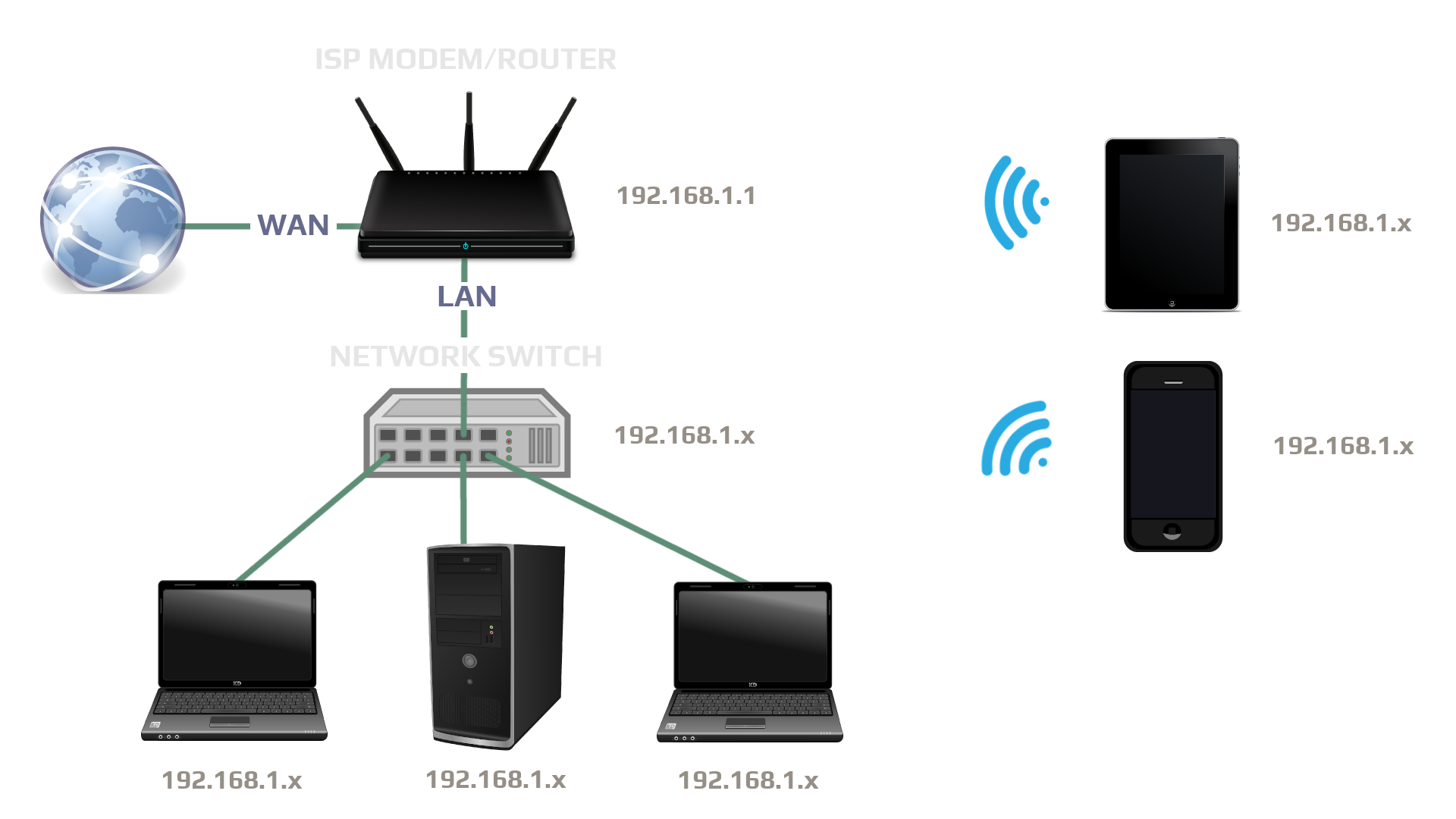TOPOLOGIES
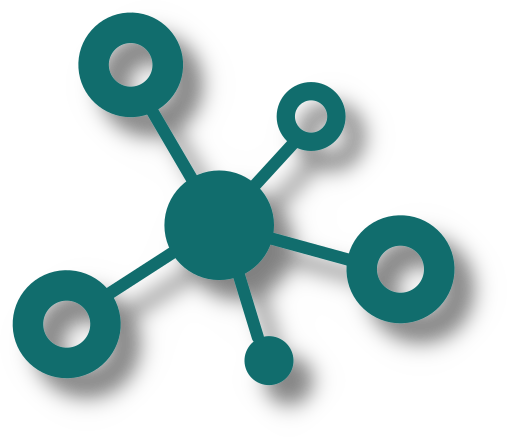
A network topology refers to the physical or logical arrangement of nodes. These may include computers, switches, routers and various other types of devices. I can be thought of as network's blueprint, which outlines the structure of the network. By understanding the network topology, network administrators and engineers can plan, manage and troubleshoot the network effectively. Examples of common and advanced topologies are shown below.
01
Single Network (basic)
These types of networks are most commonly used in a home and small office environment. They consist of a single router that provides a single network, which serves all devices on that network (ethernet & wireless). In this configuration, each device will be able to see all other devices on the network.
In this example, the following values will be used.
| Number of networks | 1 |
| Number of routers | 1 |
| Number of switches (optional) | 1 |
| Subnet | 255.255.255.0 |
| Network ID | 192.168.1.0 |
| Router IP | 192.168.1.1 |
| Router DHCP | Enabled |
| Router WiFi Channel (2.4) | 1, 6 or 11 |
| Router WiFi Channel (5.0) | Any |
| Network Devices IP | 192.168.1.x |
02
Single Network (extended)
Similar to the topology above, the example below will create a single network but with the addition of a 2nd router, that is used to extend the existing network. This may be required if you would like to extend the range of the WiFi or require additional ethernet ports. Make sure to assign different WiFi channels for each router.
In this example, the following values will be used.
| Number of networks | 1 |
| Number of routers | 2 |
| Subnet | 255.255.255.0 |
| Network ID | 192.168.1.0 |
| Main Router IP | 192.168.1.1 |
| Main Router DHCP | Enabled |
| Main Router WiFi Channel (2.4) | 1, 6 or 11 |
| Main Router WiFi Channel (5.0) | Any |
| 2nd Router IP | 192.168.1.2 |
| 2nd Router DHCP | Disabled |
| 2nd Router WiFi Channel (2.4) | 1, 6 or 11 |
| 2nd Router WiFi Channel (5.0) | Any |
| Network Devices IP | 192.168.1.x |
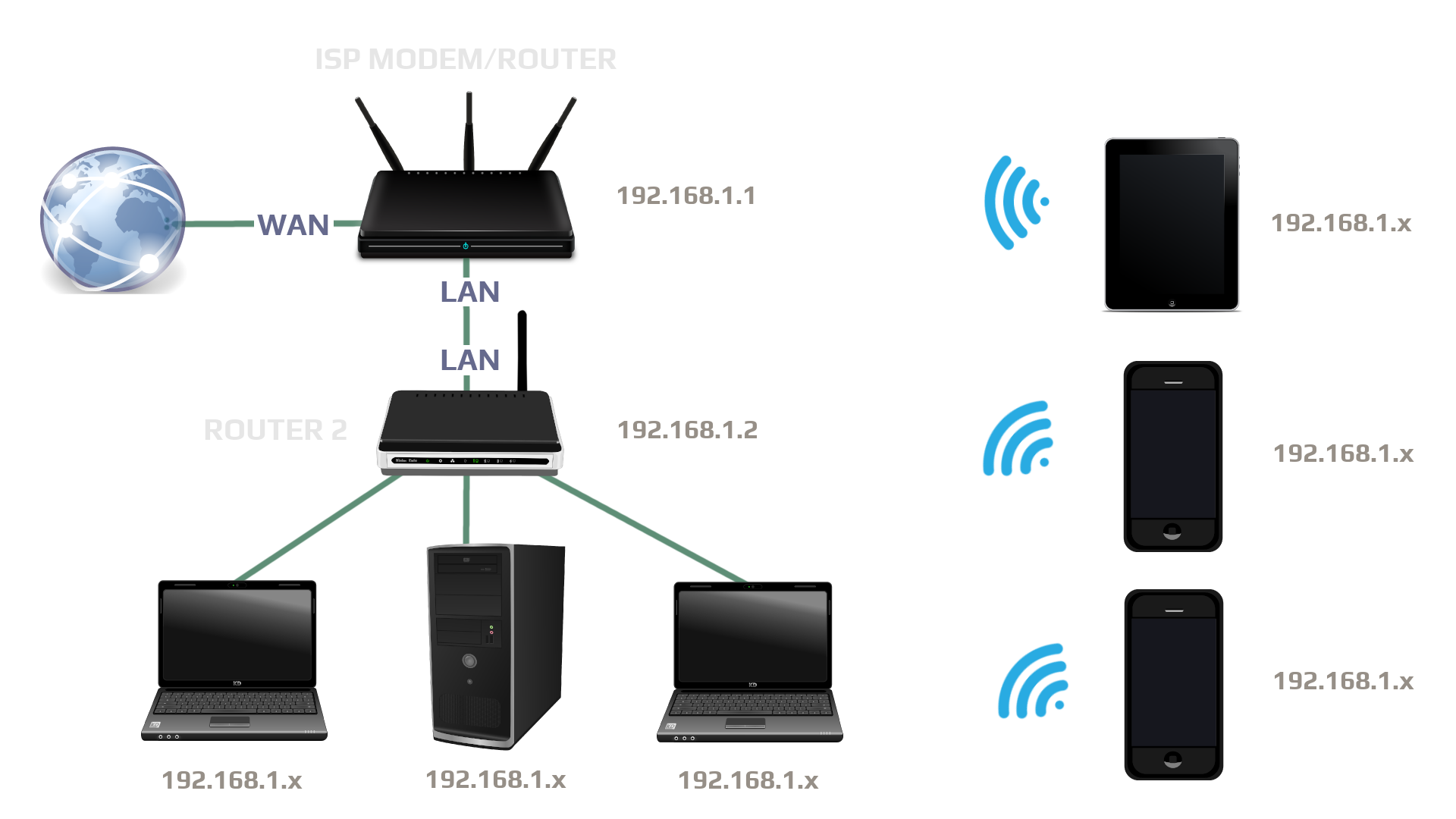
03
2 Networks (one private)
In the previous example, the second router was added to extend the network. But in this example, the second router will be added to create a separate private network. Doing this will provide a private network that cannot be seen by any other devices that do not belong to it's network. Make sure to assign different WiFi channels for each router.
In this example, the following values will be used.
| Number of networks | 2 |
| Number of routers | 2 |
| Subnet | 255.255.255.0 |
| Network ID A (main) | 192.168.1.0 |
| Network ID B (hidden) | 192.168.2.0 |
| Main Router IP | 192.168.1.1 |
| Main Router DHCP | Enabled |
| Main Router WiFi Channel (2.4) | 1, 6 or 11 |
| Main Router WiFi Channel (5.0) | Any |
| 2nd Router IP (WAN) | 192.168.1.2 |
| 2nd Router IP (LAN) | 192.168.2.1 |
| 2nd Router DHCP | Enabled |
| 2nd Router WiFi Channel (2.4) | 1, 6 or 11 |
| 2nd Router WiFi Channel (5.0) | Any |
| Network A Devices IP | 192.168.1.x |
| Network B Devices IP | 192.168.2.x |
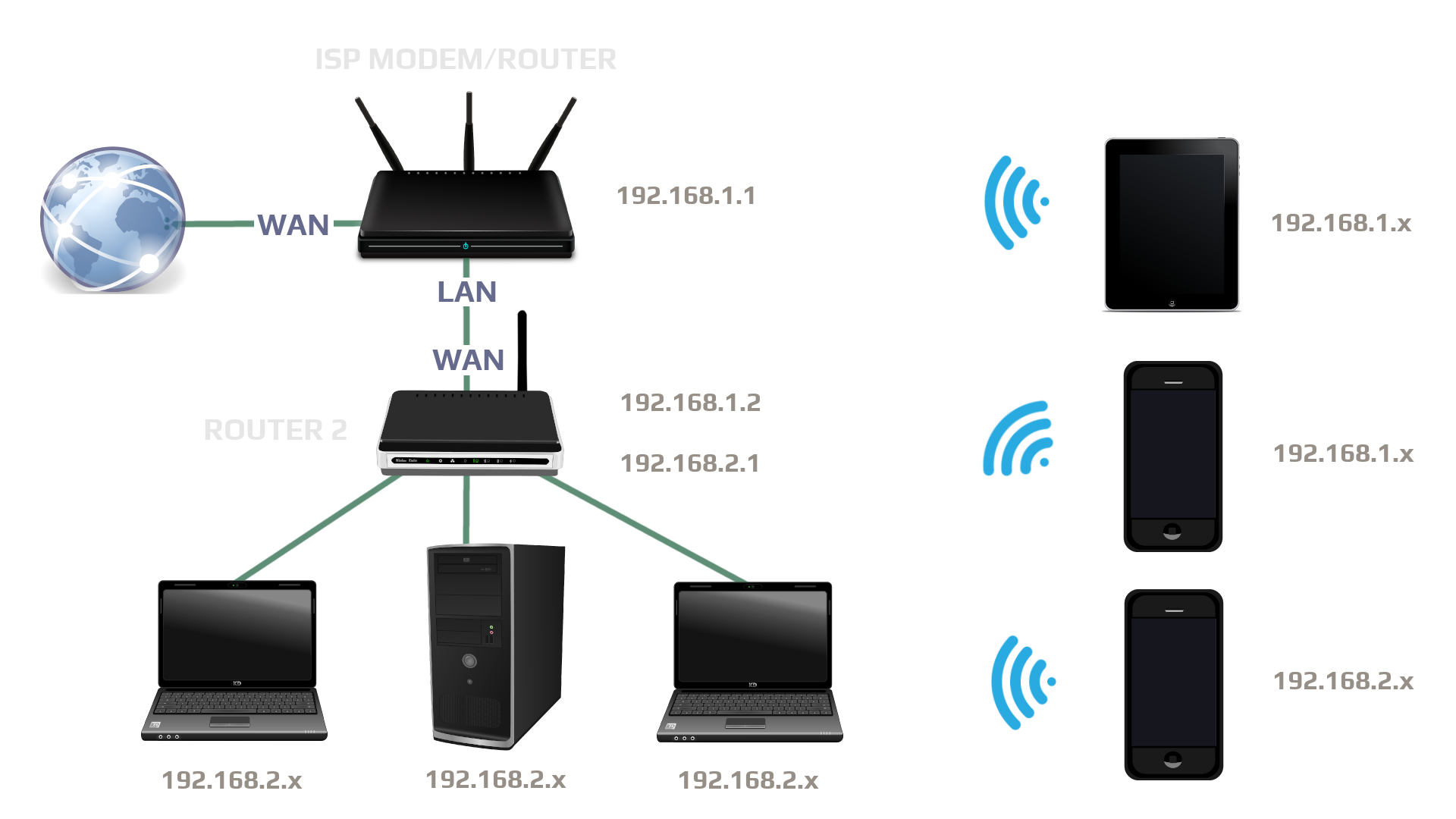
04
3 Networks (two private)
This section will cover how to configure a network with three separate routers, creating two private networks. Both of the additional routers and the devices on them will be able to communicate with devices on the first network, but devices from the first network will not be able to talk or communicate with any of the devices on either of the added (private) networks. Even these additional networks will not be able to see each other.
In this example, the following values will be used.
| Number of networks | 3 |
| Number of routers | 3 |
| Subnet | 255.255.255.0 |
| Network ID A (main) | 192.168.1.0 |
| Network ID B (hidden) | 192.168.2.0 |
| Network ID C (hidden) | 192.168.3.0 |
| Main Router IP | 192.168.1.1 |
| Main Router DHCP | Enabled |
| Main Router WiFi Channel (2.4) | 1, 6 or 11 |
| Main Router WiFi Channel (5.0) | Any |
| 2nd Router IP (WAN) | 192.168.1.2 |
| 2nd Router IP (LAN) | 192.168.2.1 |
| 2nd Router DHCP | Enabled |
| 2nd Router WiFi Channel (2.4) | 1, 6 or 11 |
| 2nd Router WiFi Channel (5.0) | Any |
| 3rd Router IP (WAN) | 192.168.1.3 |
| 3rd Router IP (LAN) | 192.168.3.1 |
| 3rd Router DHCP | Enabled |
| 3rd Router WiFi Channel (2.4) | 1, 6 or 11 |
| 3rd Router WiFi Channel (5.0) | Any |
| Network A Devices IP | 192.168.1.x |
| Network B Devices IP | 192.168.2.x |
| Network C Devices IP | 192.168.3.x |
